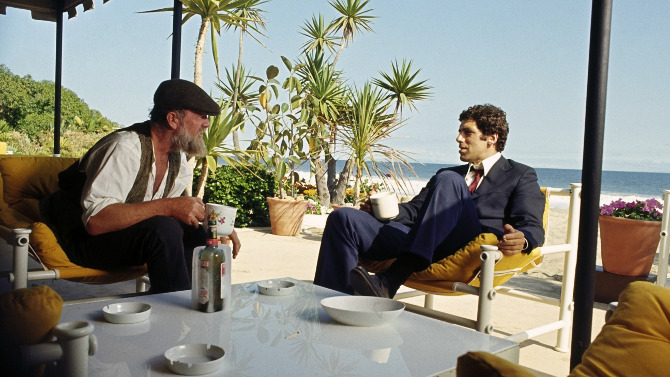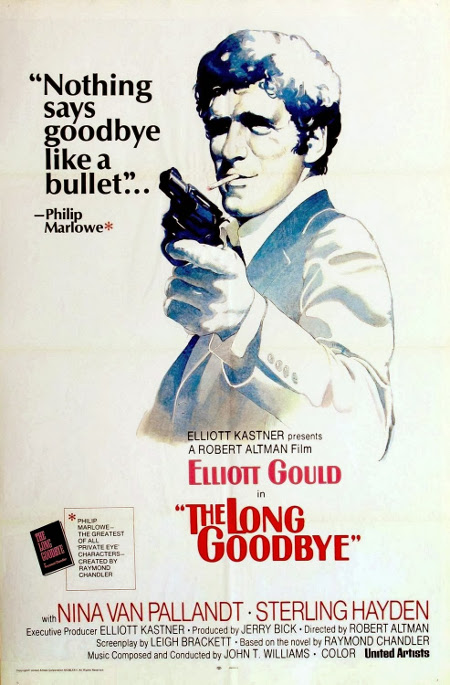Tackling Raymond Chandler’s1953 novel “The Long Goodbye” (which features detective Philip Marlowe) in a unique way, director Robert Altman decided to, “call him Rip Van Marlowe, and we took the position that he had been asleep for twenty years, woke up, and Elliott [Gould] just wandered through that film. . . and that was our idea – that he was wandering through this landscape, the film trying to invoke the morals of a previous time into this early seventies.”
Set exactly twenty years after the novel’s release date, detective Philip Marlowe (Gould) awakes in the middle of the night from a deep sleep – voice raspy, five o’clock shadow quickly moving onto six. . . a man in an endless stupor. His retro suits, skinny ties and constant smoking are out of place, much like his 1948 Cabriolet Lincoln Continental Convertible – a gent who is undoubtably from another time (even his salary closely resembles what a detective would make in the late 40s or early 50s).
Living in a fantastical abode behind the Hollywood Bowl on a secluded backstreet, his elevated apartment is attainable by private elevator, a brilliant downward vista that is only made better in that it also offers a view of his neighbours – a group of always topless hippie women who practice yoga and love making brownies (though the concept of yoga clearly baffles the man).
After struggling to feed his cat, he is visited by friend Terry Lennox (Jim Bouton), a man who has a scratch on his face and bloody knuckles. Asking for a drive to get out of town, Marlowe takes him to the Mexican border, this seemingly simple favour will turn his life upside down. Soon, the police are hassling him, as his friend’s wife has been murdered. With Terry being the prime suspect, and their only lead being Marlowe (who is unwilling to say very much of import), they grab him, and arrest him for obstruction of justice.
Released three days later, Marlowe soon learns why they let him go – Terry has turned up dead (of an apparent suicide – though the detective questions it). Coincidentally hired by Eileen Wade (Nina van Pallandt), a woman who lives in the same beachfront guarded estates as his former friend, she hopes that the PI can track down her missing author husband, Roger (Sterling Hayden – looking a little like a bearded Ernest Hemingway).
Leading down a wholly unexpected path, Marlowe searches for the author whilst investigating his friend’s supposed suicide. . . though Terry’s death once again brings in an unwanted crowd, as scorned gangster Marty Augustine (Mark Rydell), along with his crew of low level thugs, come knocking – as Terry has stolen a bag-full of money from the man. After making his point (a rough and bloody one), Marty leaves dim-witted crony Harry (David Arkin) to follow Marlowe’s every move. Will Marlowe be able to wake from his groggy state and solve the mystery, dodging foes and sketchy friends/acquaintances alike?
Though The Long Goodbye does have a plot, it is rather loose, focussing instead on its odd mystique and fascinating characters. Unlike your average fare, each persona is crafted in an interesting and memorable way – be it Gould’s laconic, sarcastic detective (our main protagonist), or the lowly security guard at the beachfront estates (Ken Samson), feeling as if they are living, breathing, real life beings. I mention Samson above as he is a true standout, a Hollywood diehard who is constantly practising his impressions (examples being Barbara Stanwyck, Cary Grant, Walter Brennan) – some of the most comedic moments come from these encounters. . . especially with Arkin’s Harry, who is perfect as a completely lacking thug whose bulb is almost nonexistent. You will also spot an unmissable (and dialogue free) cameo from Arnold Schwarzenegger, who plays another one of Augustine’s heavies. Lastly, Sterling Hayden must be highlighted, as his Hemingway-esque attitude truly impresses, a self-sabotaging alcoholic whose best days are behind him. Much of the credit for the very free-wheeling attitude of the actors must go to Altman, who allowed his talented cast to improvise on set, not even giving them marks to hit while they worked.
Set in some outstanding locales, the centrepiece is Marlowe’s spectacular abode mentioned above. Yet, each location explored has a certain magic, with Altman’s impressive beachfront home (in Malibu Colony) being used for the Wade’s, while the final moments set in Mexico are a majestic backdrop for the movie. With interesting settings selected, Altman decided upon using a unique method for filming – his camera is always moving, never allowing the viewer to get comfortable, as if we too are being chased like our protagonist. Many times, it feels like we are a voyeur from another time, always moving to catch a glimpse of this unusual world. Altman also doesn’t shy away from using the zoom lens, it playing an integral part at several points in the feature. Altman and cinematographer Vilmos Zsigmond also utilized the flashing technique throughout the motion picture – a process where the film is exposed to an even amount of light, shifting the dark tones into a lighter range, bringing forth greater visual detail rather than pitch blackness (this giving a different aura to many sequences). The Long Goodbye is one of the most pure examples of this process in film. The final product provides a much more natural, subtle colour palette, compared to the more frequently seen harsh, distinctive cinematography viewed in most film noirs or neo-noirs.
A unique reinvention of the Philip Marlowe character (Humprey Bogart it is not), The Long Goodbye is a highly original effort in the Raymond Chandler canon of motion pictures – touching on interesting themes of broken friendships and the possibility that you cannot lie to life, it goes against the grain of your prototypical detective tale. It takes chances, a unique plot (written by Leigh Brackett – who co-wrote The Big Sleep in 1946), unusual visuals, creative camera work, and a stellar score by John Williams (the theme song, written by Williams and Johnny Mercer, is ingeniously woven throughout the film – symbolic of the setting in which it is placed, it always sounded different – two examples of where it can be found are on the radio as well as being played by a Mexican band at a street procession during a funeral), all of it coming together to create something utterly different. Even the poster campaign must be highlighted – originally developing a very 1940’s style design, they cancelled it as the picture was being released, bringing in Jack Davis from Mad Magazine to differentiate it from the classic film noir it most definitely was not. So, say hello to The Long Goodbye, and enjoy its shocking ending – something more Hollywood features should shoot for.



